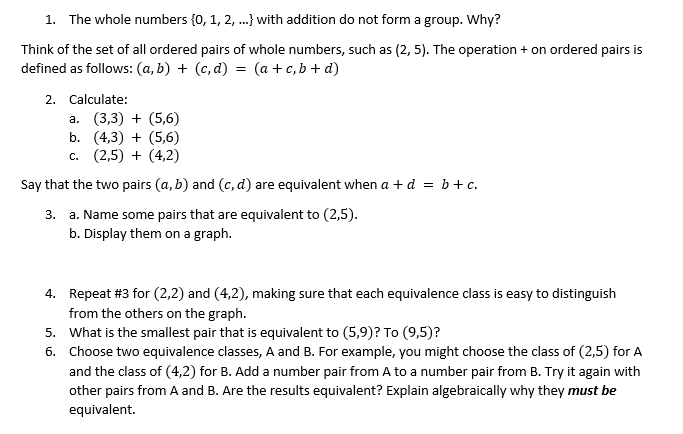4. Repeat #3 for (2,2) and (4,2), making sure that each equivalence class is easy to distinguish from the others on the graph. 5. What is the smallest pair that is equivalent to (5,9)? To (9,5)? 6. Choose two equivalence classes, A and B. For example, you might choose the class of (2,5) for
4. Repeat #3 for (2,2) and (4,2), making sure that each equivalence class is easy to distinguish from the others on the graph. 5. What is the smallest pair that is equivalent to (5,9)? To (9,5)? 6. Choose two equivalence classes, A and B. For example, you might choose the class of (2,5) for
Algebra & Trigonometry with Analytic Geometry
13th Edition
ISBN:9781133382119
Author:Swokowski
Publisher:Swokowski
Chapter10: Sequences, Series, And Probability
Section10.7: Distinguishable Permutations And Combinations
Problem 16E
Related questions
Topic Video
Question
Please answer questions 4
When answering these questions, please conduct the following:
- Summarize your work on each of the questions. Support your conclusions with evidence.
- Explain how this exercise can be used to “create integers entirely from the whole numbers.”

Transcribed Image Text:1. The whole numbers {0, 1, 2, .} with addition do not form a group. Why?
Think of the set of all ordered pairs of whole numbers, such as (2, 5). The operation + on ordered pairs is
defined as follows: (a, b) + (c, d) = (a + c, b + d)
2. Calculate:
а. (3,3) + (5,6)
b. (4,3) + (5,6)
c. (2,5) + (4,2)
Say that the two pairs (a, b) and (c, d) are equivalent when a + d =
= b+c.
a. Name some pairs that are equivalent to (2,5).
b. Display them on a graph.
3.
4. Repeat #3 for (2,2) and (4,2), making sure that each equivalence class is easy to distinguish
from the others on the graph.
5. What is the smallest pair that is equivalent to (5,9)? To (9,5)?
6. Choose two equivalence classes, A and B. For example, you might choose the class of (2,5) for A
and the class of (4,2) for B. Add a number pair from A to a number pair from B. Try it again with
other pairs from A and B. Are the results equivalent? Explain algebraically why they must be
equivalent.
Expert Solution
This question has been solved!
Explore an expertly crafted, step-by-step solution for a thorough understanding of key concepts.
Step by step
Solved in 2 steps with 2 images

Knowledge Booster
Learn more about
Need a deep-dive on the concept behind this application? Look no further. Learn more about this topic, advanced-math and related others by exploring similar questions and additional content below.Recommended textbooks for you

Algebra & Trigonometry with Analytic Geometry
Algebra
ISBN:
9781133382119
Author:
Swokowski
Publisher:
Cengage

Algebra & Trigonometry with Analytic Geometry
Algebra
ISBN:
9781133382119
Author:
Swokowski
Publisher:
Cengage